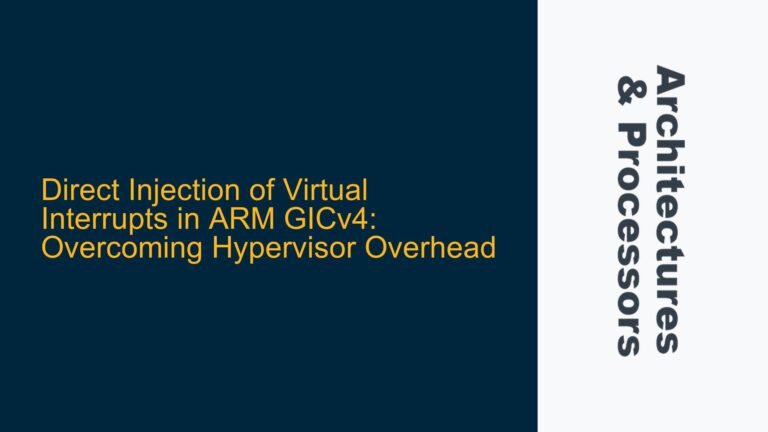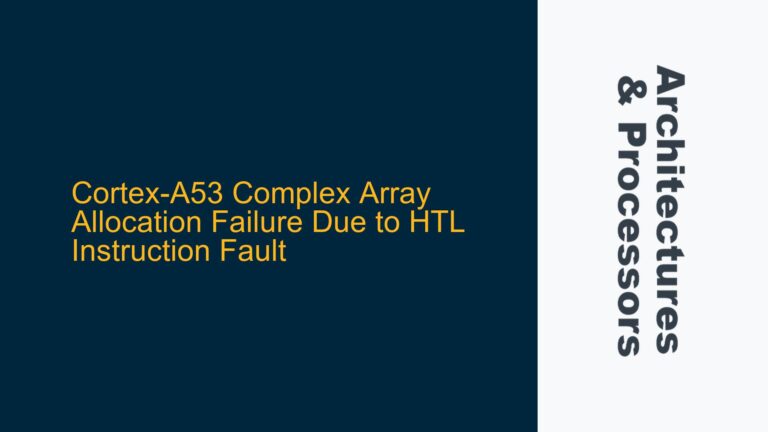ARM Cortex-A53 32-bit to 64-bit Mode Transition Challenges
The ARM Cortex-A53 processor, part of the ARMv8-A architecture, is designed to support both 32-bit (AArch32) and 64-bit (AArch64) execution states. This dual-state capability allows developers to leverage the benefits of 64-bit computing, such as larger address spaces and enhanced performance, while maintaining compatibility with existing 32-bit software. However, transitioning from 32-bit to 64-bit mode is not always straightforward and can be influenced by several factors, including hardware configuration, operating system support, and bootloader implementation.
One of the primary challenges in switching from 32-bit to 64-bit mode on the Cortex-A53 is understanding the role of the Exception Level (EL) and the hardware signals that determine the initial execution state. The Cortex-A53 processor can be configured to start in either AArch32 or AArch64 mode, depending on the state of the input signals at reset. If the processor is configured to start in AArch32 mode, it will remain in this state unless explicitly switched to AArch64 mode by software. This configuration is often determined by the System-on-Chip (SoC) designer, who may tie specific signals to enforce a particular mode.
Another challenge is the operating system’s role in determining the execution state. If the operating system kernel is 32-bit, the entire system, including user-space applications, will run in 32-bit mode. Even if the hardware supports 64-bit mode, the operating system must be capable of managing the transition between 32-bit and 64-bit execution states. This is particularly relevant in systems running Android or Linux, where the kernel’s bitness dictates the execution state of the entire system.
Hardware Configuration and Operating System Constraints
The ability to switch from 32-bit to 64-bit mode on the ARM Cortex-A53 processor is heavily influenced by both hardware configuration and operating system constraints. At the hardware level, the Cortex-A53 processor’s execution state at reset is determined by the state of the input signals, specifically the AA64nAA32 signal. If this signal is tied to a logic level that enforces 32-bit mode, the processor will start in AArch32 mode and remain in this state unless software explicitly switches it to AArch64 mode.
In many cases, the SoC designer may choose to enforce 32-bit mode at the hardware level to ensure compatibility with existing 32-bit software or to simplify the boot process. This decision is often made during the design phase and is not easily changed without modifying the hardware. Additionally, the bootloader plays a critical role in determining the execution state. If the bootloader is 32-bit, it will load a 32-bit operating system kernel, which in turn will run user-space applications in 32-bit mode.
At the operating system level, the kernel’s bitness is a determining factor in the execution state. A 32-bit kernel cannot run 64-bit user-space applications, and vice versa. In systems running Android or Linux, the kernel must be compiled for the desired execution state. For example, if the goal is to run a 64-bit operating system, the kernel must be compiled for AArch64. This requires not only a 64-bit kernel but also 64-bit versions of all user-space libraries and applications.
The operating system’s ability to manage the transition between 32-bit and 64-bit execution states is also critical. In some cases, it may be possible to run a mixed-mode system where the kernel is 64-bit, but certain user-space applications are 32-bit. This requires the operating system to support both execution states simultaneously, which is typically achieved through the use of compatibility layers or multi-architecture support.
Implementing a 64-bit Execution Environment on Cortex-A53
To successfully switch from 32-bit to 64-bit mode on the ARM Cortex-A53 processor, several steps must be taken to ensure that both the hardware and software are properly configured to support 64-bit execution. The first step is to verify the hardware configuration, specifically the state of the AA64nAA32 signal at reset. If the signal is tied to enforce 32-bit mode, it may be necessary to modify the hardware design or use a different SoC that supports 64-bit mode.
Once the hardware configuration is confirmed, the next step is to ensure that the bootloader supports 64-bit mode. The bootloader is responsible for loading the operating system kernel, and if it is 32-bit, it will only be able to load a 32-bit kernel. Therefore, the bootloader must be updated or replaced with a 64-bit version that can load a 64-bit kernel. This may involve modifying the bootloader source code or using a pre-built 64-bit bootloader.
The operating system kernel must also be compiled for 64-bit mode. This requires selecting the appropriate configuration options during the kernel build process and ensuring that all necessary 64-bit libraries and drivers are available. In the case of Linux, this typically involves selecting the ARCH=arm64 option and configuring the kernel to support the specific hardware platform.
Once the 64-bit kernel is built and loaded, the final step is to ensure that all user-space applications and libraries are compatible with 64-bit mode. This may involve recompiling existing 32-bit applications for 64-bit or obtaining 64-bit versions of third-party libraries. In some cases, it may be necessary to use a compatibility layer to run 32-bit applications on a 64-bit system.
In summary, switching from 32-bit to 64-bit mode on the ARM Cortex-A53 processor requires careful consideration of both hardware and software factors. By verifying the hardware configuration, updating the bootloader, compiling a 64-bit kernel, and ensuring compatibility of user-space applications, it is possible to successfully transition to a 64-bit execution environment. However, this process can be complex and may require significant effort, particularly in systems where the hardware or operating system constraints are not easily modified.






